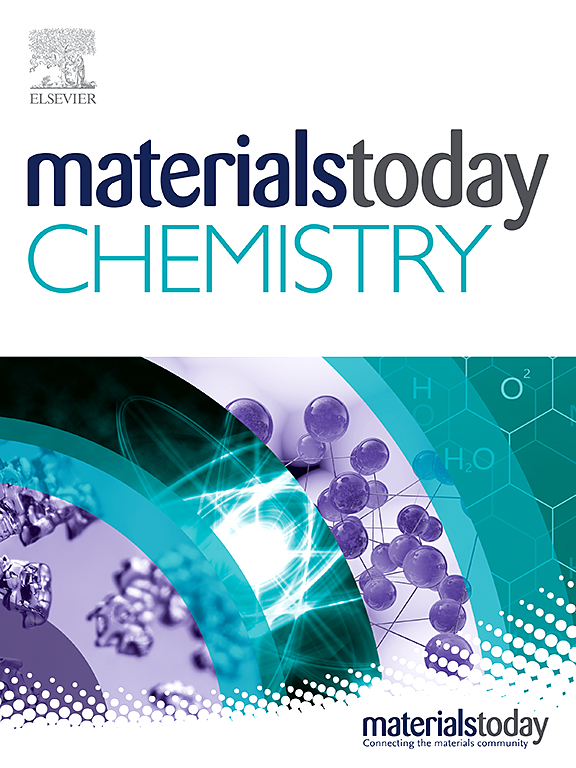A new zero-dimensional hybrid antimony halide of (C25H46N)2SbCl5 with dual-emission and high quantum-efficiency for light-emitting application
IF 6.7
2区 化学
Q1 CHEMISTRY, MULTIDISCIPLINARY
引用次数: 0
Abstract
Zero-dimensional (0D) organic-inorganic hybrid metal halides (OIHMHs) have received extensive attention due to their excellent photoelectric properties. Herein, a new 0D OIHMH single crystal, (CHN)SbCl, has been synthesized by slow antisolvent diffusion. In this crystal structure, CHN (CHN = Cetyldimethylbenzylammonium cations) cations separated SbCl to form a 0D square pyramid structure. (CHN)SbCl single crystals (SCs) manifest bright orange-yellow dual-emission bands at 472 and 616 nm, while having a high photoluminescent quantum yield of 97.5 %. The lifetime of high energy (HE) emission and low energy (LE) emission at room temperature is 9.73 ns and 4.61 μs, respectively. Based on lifetime differences and temperature-dependent spectra, the HE emission band is ascribed to singlet self-trapped excitons (STEs), while the LE emission band with a broad full width at half maxima of 136 nm can be attributed to triplet STEs. (CHN)SbCl appeared anti-thermal quenching behavior. In accordance with the luminescence characteristics of (CHN)SbCl, a warm white light-emitting diode device was fabricated with the correlated color temperature of 3410 K, the relevant color coordinate of (0.41, 0.39) and the color rendering index of 95.1, demonstrating (CHN)SbCl a promising phosphor for solid-state light-emitting application.具有双发射和高量子效率的新型零维混合卤化锑 (C25H46N)2SbCl5 的发光应用
零维(0D)有机-无机杂化金属卤化物(OIHMHs)因其优异的光电特性而受到广泛关注。在此,我们通过缓慢的反溶剂扩散法合成了一种新的 0D OIHMH 单晶 (CHN)SbCl。在该晶体结构中,CHN(CHN = 乙基二甲基苄基铵阳离子)阳离子与 SbCl 分离,形成 0D 方形金字塔结构。(CHN)SbCl单晶体(SCs)在472和616纳米波长处显示出明亮的橙黄色双发射带,同时具有97.5%的高光量子产率。室温下,高能量(HE)发射和低能量(LE)发射的寿命分别为 9.73 ns 和 4.61 μs。根据寿命差异和随温度变化的光谱,高能发射带可归因于单重自俘获激子(STE),而具有 136 nm 宽全宽半极大值的低能发射带可归因于三重 STE。(CHN)SbCl出现了抗热淬行为。根据(CHN)SbCl 的发光特性,制备了暖白光发光二极管器件,其相关色温为 3410 K,相关色坐标为 (0.41,0.39),显色指数为 95.1,表明(CHN)SbCl 是一种具有良好应用前景的固态发光荧光粉。
本文章由计算机程序翻译,如有差异,请以英文原文为准。
求助全文
约1分钟内获得全文
求助全文
来源期刊

Materials Today Chemistry
Multiple-
CiteScore
8.90
自引率
6.80%
发文量
596
审稿时长
33 days
期刊介绍:
Materials Today Chemistry is a multi-disciplinary journal dedicated to all facets of materials chemistry.
This field represents one of the fastest-growing areas of science, involving the application of chemistry-based techniques to the study of materials. It encompasses materials synthesis and behavior, as well as the intricate relationships between material structure and properties at the atomic and molecular scale. Materials Today Chemistry serves as a high-impact platform for discussing research that propels the field forward through groundbreaking discoveries and innovative techniques.
 求助内容:
求助内容: 应助结果提醒方式:
应助结果提醒方式:


